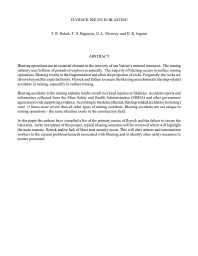Mining Publication: Flyrock Issues in Blasting
Original creation date: February 2001
Blasting operations are an essential element in the recovery of our Nation's mineral resources. The mining industry uses billions of pounds of explosives annually. The majority of blasting occurs in surface mining operations. Blasting results in the fragmentation and often the projection of rocks. Frequently, the rocks are thrown beyond the expected limits. Flyrock and failure to secure the blasting area dominate blasting-related accidents in mining, especially in surface mining. Blasting accidents in the mining industry tend to result in critical injuries or fatalities. Accident reports and information collected from the Mine Safety and Health Administration (MSHA) and other government agencies provide supporting evidence. According to the data collected, blasting-related accidents (in mining) were 11 times more severe than all other types of mining accidents. Blasting accidents are not unique to mining operations - the same situation exists in the construction field. In this paper the authors have compiled a list of the primary causes of flyrock and the failure to secure the blast area. In the next phase of this project, typical blasting scenarios will be reviewed which will highlight the main reasons flyrock and/or lack of blast area security occur. This will alert miners and construction workers to the current problems/hazards associated with blasting and to identify other safety measures to protect personnel.
Authors: TR Rehak, TS Bajpayee, GL Mowrey, DK Ingram
Conference Paper - February 2001
NIOSHTIC2 Number: 20021418
Proc 27th Ann Conf Explos Blasting Tech, ISEE, Cleveland, Ohio, 2001 Feb, 1:165-175
See Also
- An Analysis and Prevention of Flyrock Accidents in Surface Blasting Operations
- Blasting and Explosives
- Blasting Injuries in Surface Mining with Emphasis on Flyrock and Blast Area Security
- Blasting Safety - Revisiting Site Security
- Fatal Accidents Due to Flyrock and Lack of Blast Area Security and Working Practices in Mining
- Reducing Non-Contact Electric Arc Injuries: An Investigation of Behavioral and Organizational Issues
- A Summary of Fatal Accidents Due to Flyrock and Lack of Blast Area Security in Surface Mining, 1989 to 1999
- Technology News 483 - Safety Training Tools for Rock Scaling Personnel
- Technology News 522 - Blast Area Security: Flyrock Safety
- Toolbox Training on Flyrock Awareness
- Page last reviewed: 9/8/2015
- Page last updated: 9/8/2015
- Content source: National Institute for Occupational Safety and Health, Mining Program


 ShareCompartir
ShareCompartir
